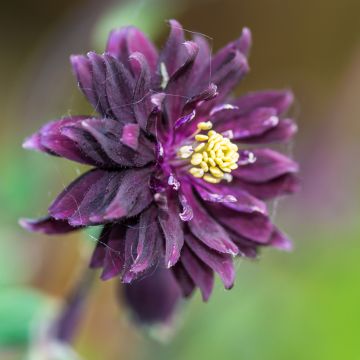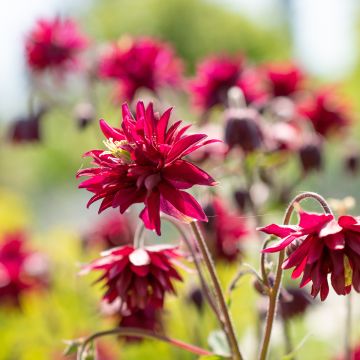

Aquilegia Sunshine Seeds - Columbine
Aquilegia Sunshine Seeds - Columbine
Aquilegia x caerulea Sunshine
Columbine, Granny's Bonnet
Special offer!
Receive a €20 voucher for any order over €90 (excluding delivery costs, credit notes, and plastic-free options)!
1- Add your favorite plants to your cart.
2- Once you have reached €90, confirm your order (you can even choose the delivery date!).
3- As soon as your order is shipped, you will receive an email containing your voucher code, valid for 3 months (90 days).
Your voucher is unique and can only be used once, for any order with a minimum value of €20, excluding delivery costs.
Can be combined with other current offers, non-divisible and non-refundable.
Why not try an alternative variety in stock?
View all →This plant carries a 6 months recovery warranty
More information
We guarantee the quality of our plants for a full growing cycle, and will replace at our expense any plant that fails to recover under normal climatic and planting conditions.
Would this plant suit my garden?
Set up your Plantfit profile →
Description
Aquilegia 'Sunshine' is a very attractive hybrid variety that forms gorgeous, large, bright yellow fully double blooms with long spurs from late spring to mid-summer. This hardy and easy to grow perennial has a bushy habit and attractive bluish-green foliage. Although it is rather short-lived, it self-seeds abundantly in cool, well-drained soil, preferably in part shade.
Aquilegia 'Sunshine' is a hybrid variety selected from the Blue Columbine, the Colorado state flower (Aquilegia caerulea). This North American species belongs to the Buttercup or Ranunculaceae family and can be found growing wild throughout the Rocky Mountains. 'Sunshine' forms a compact, upright clump that grows to a height of about 60 cm in full bloom, for a width of 30 cm. For 4-6 weeks from June to July, large flowers emerge at the tip of sturdy stems. They measure 5-7 cm in diameter, with a double corolla and long horned spurs. They display two harmonious tones of yellow: bright, soft pastel yellow and creamy, pale yellow. The bluish-green leaves have a lacy, delicate clover-like appearance. Aquilegias are short-lived perennials; flowering generally reaches its peak after 2 or 3 years of cultivation. Although they self-seed easily, they are not always true to type when different varieties of columbine are grown in close proximity.
Columbines or Granny's Bonnets have been popular ornamental garden plants since the Middle Ages. They will fit in just about anywhere, bringing a discreet lightness and fantasy to mixed borders and perennial beds; they are ideal for underplanting shrubs and trees, growing up slopes or decorating shady rock gardens. They are excellent cut flowers. In old-fashioned cottage style gardens, columbines combine well with perennials such as foxgloves, bellflowers, wood cranesbill, bleeding hearts or lady’s mantle.
Report an error about the product description
Flowering
Foliage
Plant habit
Botanical data
Aquilegia
x caerulea
Sunshine
Ranunculaceae
Columbine, Granny's Bonnet
Cultivar or hybrid
Other Aquilegia Colombine Seeds
View all →Planting and care
Sow from spring to midsummer in light, free-draining sowing mix and cover lightly. Germination can take 1 to 3 months at 15-21°C. To speed up the process, place the seed trays in a polyethylene bag and leave them in the refrigerator for 3 weeks. Check on them regularly and take them out of the refrigerator once they start to germinate, moving them to a warmer place (15 to 21 °C). When they are strong enough to be handled, transplant them into small pots. Place them in a cold frame and plant out their final locations in autumn.
Aquilegia caerulea likes moist, rich, free-draining soils and prefers part shade or dappled sunlight in the afternoon. It adapts well to limestone. Although it is very disease-resistant, it is often subject to to attacks by aphids, caterpillars, slugs and snails. Since columbines self-seed easily, it is possible to let several flower stems go to seed after flowering. However, we recommend only doing this on strong, vigorous plants as this exhausts the plants prematurely, thus diminishing their already short lifespan (3 to 4 years).
Sowing period
Intended location
This item has not been reviewed yet - be the first to leave a review about it.
Similar products
Haven't found what you were looking for?
Hardiness is the lowest winter temperature a plant can endure without suffering serious damage or even dying. However, hardiness is affected by location (a sheltered area, such as a patio), protection (winter cover) and soil type (hardiness is improved by well-drained soil).

Photo Sharing Terms & Conditions
In order to encourage gardeners to interact and share their experiences, Promesse de fleurs offers various media enabling content to be uploaded onto its Site - in particular via the ‘Photo sharing’ module.
The User agrees to refrain from:
- Posting any content that is illegal, prejudicial, insulting, racist, inciteful to hatred, revisionist, contrary to public decency, that infringes on privacy or on the privacy rights of third parties, in particular the publicity rights of persons and goods, intellectual property rights, or the right to privacy.
- Submitting content on behalf of a third party;
- Impersonate the identity of a third party and/or publish any personal information about a third party;
In general, the User undertakes to refrain from any unethical behaviour.
All Content (in particular text, comments, files, images, photos, videos, creative works, etc.), which may be subject to property or intellectual property rights, image or other private rights, shall remain the property of the User, subject to the limited rights granted by the terms of the licence granted by Promesse de fleurs as stated below. Users are at liberty to publish or not to publish such Content on the Site, notably via the ‘Photo Sharing’ facility, and accept that this Content shall be made public and freely accessible, notably on the Internet.
Users further acknowledge, undertake to have ,and guarantee that they hold all necessary rights and permissions to publish such material on the Site, in particular with regard to the legislation in force pertaining to any privacy, property, intellectual property, image, or contractual rights, or rights of any other nature. By publishing such Content on the Site, Users acknowledge accepting full liability as publishers of the Content within the meaning of the law, and grant Promesse de fleurs, free of charge, an inclusive, worldwide licence for the said Content for the entire duration of its publication, including all reproduction, representation, up/downloading, displaying, performing, transmission, and storage rights.
Users also grant permission for their name to be linked to the Content and accept that this link may not always be made available.
By engaging in posting material, Users consent to their Content becoming automatically accessible on the Internet, in particular on other sites and/or blogs and/or web pages of the Promesse de fleurs site, including in particular social pages and the Promesse de fleurs catalogue.
Users may secure the removal of entrusted content free of charge by issuing a simple request via our contact form.
The flowering period indicated on our website applies to countries and regions located in USDA zone 8 (France, the United Kingdom, Ireland, the Netherlands, etc.)
It will vary according to where you live:
- In zones 9 to 10 (Italy, Spain, Greece, etc.), flowering will occur about 2 to 4 weeks earlier.
- In zones 6 to 7 (Germany, Poland, Slovenia, and lower mountainous regions), flowering will be delayed by 2 to 3 weeks.
- In zone 5 (Central Europe, Scandinavia), blooming will be delayed by 3 to 5 weeks.
In temperate climates, pruning of spring-flowering shrubs (forsythia, spireas, etc.) should be done just after flowering.
Pruning of summer-flowering shrubs (Indian Lilac, Perovskia, etc.) can be done in winter or spring.
In cold regions as well as with frost-sensitive plants, avoid pruning too early when severe frosts may still occur.
The planting period indicated on our website applies to countries and regions located in USDA zone 8 (France, United Kingdom, Ireland, Netherlands).
It will vary according to where you live:
- In Mediterranean zones (Marseille, Madrid, Milan, etc.), autumn and winter are the best planting periods.
- In continental zones (Strasbourg, Munich, Vienna, etc.), delay planting by 2 to 3 weeks in spring and bring it forward by 2 to 4 weeks in autumn.
- In mountainous regions (the Alps, Pyrenees, Carpathians, etc.), it is best to plant in late spring (May-June) or late summer (August-September).
The harvesting period indicated on our website applies to countries and regions in USDA zone 8 (France, England, Ireland, the Netherlands).
In colder areas (Scandinavia, Poland, Austria...) fruit and vegetable harvests are likely to be delayed by 3-4 weeks.
In warmer areas (Italy, Spain, Greece, etc.), harvesting will probably take place earlier, depending on weather conditions.
The sowing periods indicated on our website apply to countries and regions within USDA Zone 8 (France, UK, Ireland, Netherlands).
In colder areas (Scandinavia, Poland, Austria...), delay any outdoor sowing by 3-4 weeks, or sow under glass.
In warmer climes (Italy, Spain, Greece, etc.), bring outdoor sowing forward by a few weeks.





















































